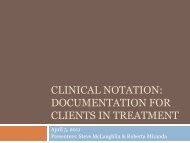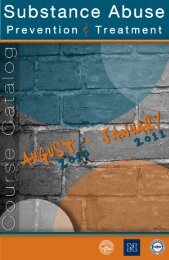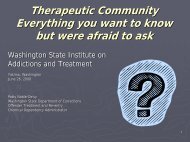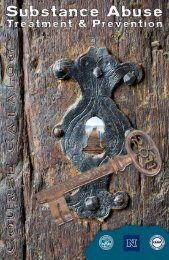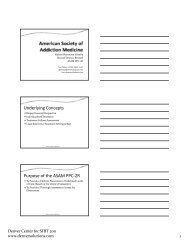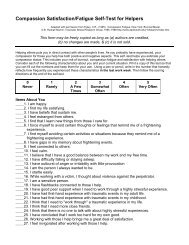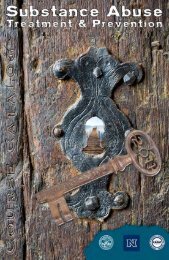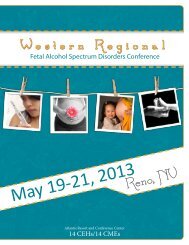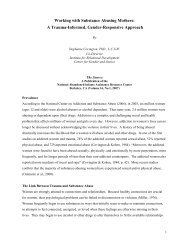Wickwire, E. M., Jr., Burke, R. S., Brown, S. A., Parker, J. D. ... - CASAT
Wickwire, E. M., Jr., Burke, R. S., Brown, S. A., Parker, J. D. ... - CASAT
Wickwire, E. M., Jr., Burke, R. S., Brown, S. A., Parker, J. D. ... - CASAT
Create successful ePaper yourself
Turn your PDF publications into a flip-book with our unique Google optimized e-Paper software.
Downloaded By: [University Nevada Reno] At: 18:59 1 July 2009METHODSParticipantsParticipants were 157 male African-American (62.2%) andCaucasian (37.8%) military veterans (mean age = 46.5 years,SD= 8.21) consecutively enrolled in primary residential orday treatment for substance use disorders. Twenty-four percentof the sample reported being single, 14% were married, and57.3% were divorced or separated. Participants reported amean of 12.9 years (SD = 2.0) of education. Based on aclinical interview, all participants met criteria for substancedependence, with alcohol, cocaine, and marijuana dependencebeing major problems within this sample. Thirty-six percent ofparticipants were also diagnosed with a co-occurring psychiatriccondition, including psychotic disorders (14.8%), mooddisorders (12.1%), post-traumatic stress disorder (6.0%),cognitive disorders (1.1%), personality disorder (0.7%), ormultiple psychiatric diagnoses (2.7%).MeasuresAddiction Severity Index (ASI)The ASI 22 is a semi-structured interview that assessesdemographics as well as recent (ie, 30-day) difficulties withsubstance abuse and five related domains likely to be impactedby substance abuse (i.e., medical, employment/economic,legal, family/social, and psychiatric). For each of the sevendomains, the ASI yields non-standardized composite scoresranging from .00 to 1.00 with higher scores indicting greaterproblem severity. In the current study, we utilized the medicalcomposite subscale score of the ASI.National Opinion Research Center DSM-IV Screen forGambling Problems (NODS)The NODS 4 is a 21-item measure designed to assessproblematic gambling behaviors. In the present study, thelifetime version of the NODS was used. The first four questionsaddress gambling history and serve as screening items. Inthe original NODS report, 4 individuals who reported everhaving lost $100 or more in a day were administered theremainder of the questionnaire. These 17 items address the10 DSM-IV diagnostic criteria for pathological gambling andare scored using a yes–no format. 7 Total scores can rangefrom 0 to 10, with higher scores indicating more gamblingproblems. A score of 1 or 2 indicates at-risk gambling, anda score of 3 or 4 suggests problem gambling. Individualswho score 5 or more are labeled pathological gamblers. Toaccommodate the range of socioeconomic statuses of patientsin our treatment program, in the current study, individualswho reported ever having gambled were administered the fullquestionnaire. Gerstein et al. 4 reported excellent test-retestreliability for the lifetime NODS (r=.99, p= .01). Amongindividuals seeking treatment for pathological gambling, theNODS has demonstrated fair to good internal consistency. 18,23Convergent validity has been displayed by correlating scoreson the NODS with scores on the SOGS, with correlationsranging from r= .71 (p< .01) 23 to r= .86 (p< .001). 18South Oaks Gambling Screen (SOGS)The SOGS 17 assesses negative feelings and behaviorsassociated with gambling involvement. Twenty items are eitheranswered affirmatively or negatively and yield a score of1 or 0, respectively. Scores of 5 or more suggest probablepathological gambling. The SOGS has demonstrated adequatereliability and validity, including an excellent Cronbach’salpha (α= 0.97) and adequate test-retest correlation (r=0.71, p< .01). 17 Convergent validity was demonstrated bycomparing the SOGS scores with counselors’ assessmentof pathological gambling for an inpatient sample (r= 0.86,p< .01). 17ProcedureThis study was approved by the Veterans Affairs MedicalCenter Research and Development Committee. As part of aroutine intake assessment, all participants were administeredthe ASI, NODS, and SOGS within the first few days followingtheir admission to the treatment program.RESULTSGambling BehaviorLifetime gambling was assessed using the NODS, and88% (n= 138) of the sample reported having gambled atleast once in their lives. Involvement in specific gamblingactivities was assessed using the SOGS, and 52.8% of thesample (n = 83) reported regular gambling (weekly or dailyparticipation in at least one gambling activity). Using a 0–1coding system for no involvement versus any involvement,respectively, the most common forms of gambling wereplaying games of skill (eg, “bowling, shooting pool, playinggolf, or playing some other game of skill for money”; 22.3%,n = 35), bingo (21.0%, n= 33), betting on state lotteries(20.4%, n = 32), and playing cards for money (20.4%, n=32).The mean SOGS score was 2.19 (SD = 3.94). Based onSOGS scores, participants were divided into two problemgambling categories: no problem (86.6%) and probablepathological (13.5%). The mean NODS score was 1.50 (SD =2.67). Based on NODS scores, participants were divided intofour problem gambling categories: no problem (58%), at-risk(17.4%), problem (8.7%), and pathological (15.9%). Table 1presents rates of problem gambling for the SOGS and NODS.Internal Consistency of the SOGS and NODSThe SOGS and NODS both demonstrated good internalconsistency (α= .93 and α= .88, respectively).Concurrent ValidityIn order to evaluate the concurrent validity of the NODS,we correlated raw scores on the NODS with raw scores on theSOGS. A strong positive correlation (r = .85, p



